Microbial Community Structure and Metabolic Function in the Venom Glands of the Predatory Stink Bug, Picromerus lewisi (Hemiptera: Pentatomidae)
Abstract
:Simple Summary
Abstract
1. Introduction
2. Materials and Methods
2.1. Insects and Samples
2.2. Anatomy of the Venom Glands
2.3. Isolation of Culturable Microorganisms from the Venom Glands of P. lewisi
2.4. Molecular Characterization
2.5. DNA Extraction, PCR Amplification, and Illumina NovaSeq PE250 Sequencing
2.6. Sequence Processing and Microbial Diversity Analysis
2.7. Metabolic Functional Analysis of Carbon Sources in Microbial Communities
2.8. Statistics Analysis
3. Results
3.1. Culturable Microorganisms from the Venom Glands of P. lewisi
3.2. Sequencing Data Statistics and Analysis
3.3. Microbial Community in the Venom Glands of P. lewisi
3.4. PICRUSt and FUNGuild Functional Prediction Analysis
3.5. Metabolic Activities of Microbial Communities in the Venom Glands of P. lewisi towards Diverse Carbon Sources
4. Discussion
5. Conclusions
Author Contributions
Funding
Data Availability Statement
Acknowledgments
Conflicts of Interest
References
- Chen, X.X.; Du, Y.J.; Huang, J.H.; Li, S.; Jiang, D.H.; Mo, M.H.; Pang, H.; Sun, X.L.; Wang, Q. Recent progresses in biological control of crop pathogens and insect pests in China. Plant Prot. 2023, 49, 340–370. [Google Scholar] [CrossRef]
- Velasco-Hernandez, M.C.; Shameer, K.S.; Nasser, M.; Moya-Raygoza, G.; Hardy, I.C.W. Contests between beneficial natural enemies: Brood-guarding parasitoids vs. foraging predators. Entomol. Exp. Appl. 2021, 169, 209–218. [Google Scholar] [CrossRef]
- Deka, B.; Baruah, C.; Babu, A. Entomopathogenic microorganisms: Their role in insect pest management. Egypt. J. Biol. Pest. Control 2021, 31, 121. [Google Scholar] [CrossRef]
- Plata-Rueda, A.; Martínez, L.C.; Zanuncio, J.C.; Serrão, J.E. Advances zoophytophagous stinkbugs (Pentatomidae) use in agroecosystems: Biology, feeding behavior and biological control. J. Pest. Sci. 2022, 95, 1485–1500. [Google Scholar] [CrossRef]
- Yoshimura, H.; Tabuchi, K.; Konishi, K. Ecological aspect of the larval parasitoid Diadegma hiraii (Hymenoptera: Ichneumonidae) as a potential biological control agent of soybean pod borer Leguminivora glycinivorella (Lepidoptera: Tortricidae). Environ. Entomol. 2023, 52, 309–316. [Google Scholar] [CrossRef]
- Weirauch, C.; Schuh, R.T. Systematics and evolution of Heteroptera: 25 years of progress. Annu. Rev. Entomol. 2011, 56, 487–510. [Google Scholar] [CrossRef]
- Walker, A.A.; Madio, B.; Jin, J.; Undheim, E.A.; Fry, B.G.; King, G.F. Melt with This Kiss: Paralyzing and Liquefying Venom of the Assassin Bug Pristhesancus plagipennis (Hemiptera: Reduviidae). Mol. Cell. Proteom. 2017, 16, 552–566. [Google Scholar] [CrossRef]
- Fischer, M.L.; Wielsch, N.; Heckel, D.G.; Vilcinskas, A.; Vogel, H. Context-dependent venom deployment and protein composition in two assassin bugs. Ecol. Evol. 2020, 10, 9932–9947. [Google Scholar] [CrossRef] [PubMed]
- Walker, A.A.; Weirauch, C.; Fry, B.G.; King, G.F. Venoms of Heteropteran Insects: A Treasure Trove of Diverse Pharmacological Toolkits. Toxins 2016, 8, 43. [Google Scholar] [CrossRef]
- Edwards, J.S. The action and composition of the saliva of an assassin bug Platymeris rhadamanthus Gaerst. (Hemiptera, Reduviidae). J. Exp. Biol. 1961, 38, 61–77. [Google Scholar] [CrossRef]
- Jiang, S.; Li, H.; Wu, K. Predation and Control Effect of Eupeodes corollae Fabricius (Diptera: Syrphidae) on Leguminous Plant Aphids. Agronomy 2023, 13, 1739. [Google Scholar] [CrossRef]
- Zhang, Q.; Zhang, R.; Zhang, Q.; Ji, D.; Zhou, X.; Jin, L. Functional Response and Control Potential of Orius sauteri (Hemiptera: Anthocoridae) on Tea Thrips (Dendrothrips minowai Priesner). Insects 2021, 12, 1132. [Google Scholar] [CrossRef] [PubMed]
- Wang, Y.; Wang, Y.N.; Wang, K.; Fang, L.; Su, H.H. The Predation Efficacy of Arma chinensis Fallou to Larvae of Diaphania indica Saunders. Chin. J. Biol. Control 2024, 40, 813–819. [Google Scholar] [CrossRef]
- Yao, Y.; He, Y.; Zhang, L.; Wang, K.; Li, B.; Du, G.Z.; Zhu, C.Y.; Yi, X.C.; Liu, Y.Y.; Zi, S.J.; et al. Management strategy for Spodoptera frugiperda (Lepidoptera: Noctuidae) in mountain maize planting areas in China. J. Asia Pac. Entomol. 2023, 26, 102152. [Google Scholar] [CrossRef]
- Wang, Y.; Brożek, J.; Dai, W. Comparative Morphology of the Mouthparts in Three Predatory Stink Bugs (Heteroptera: Asopinae) Reveals Feeding Specialization of Stylets and Sensilla. Insects 2020, 11, 762. [Google Scholar] [CrossRef]
- Zhao, P.; Wan, R.J.; Liu, H.X. Notes on the Subfamily Asopinae (Heteroptera: Pentatomidae) from Guizhou Province. J. Kaili Univ. 2016, 34, 76–80. [Google Scholar] [CrossRef]
- Wang, Y.; Wang, M.Q.; Zhang, H.M.; Zhao, X.Q.; Yin, Y.Q.; Li, X.Y.; Tang, Y.T.; Chen, B.; Chen, F.S.; Zhang, L. Predation potential of adult of Picromerus lewisi (Fallou) on larvae of Spodoptera frugiperda. Chin. J. Biol. Control 2019, 35, 691–697. [Google Scholar] [CrossRef]
- Fu, C.Y.; Xu, T.M.; Wen, S.H.; Zhang, S.; Liu, F.; Du, G.Z.; Chen, B.; Zhang, L.M. Predation behaviors and functional responses of Picromerus lewisi to the larvae of Ostrinia furnacalis. Chin. J. Biol. Control 2021, 37, 956–962. [Google Scholar] [CrossRef]
- Tang, Y.T.; Guo, Y.; He, G.W.; Liu, C.X.; Chen, H.Y.; Zhang, L.S.; Wang, M.Q. Functional Responses of Picromerus lewisi Scott (Hemiptera: Pentatomidae) Attacking Mythimna separata (Walker) (Lepidoptera: Noctuidae). Chin. J. Biol. Control 2018, 34, 825–830. [Google Scholar] [CrossRef]
- Gao, F.D.; Tian, L.; Li, X.Y.; Zhang, Y.Q.; Wang, T.F.; Ma, L.; Song, F.; Cai, W.Z.; Li, H. Proteotranscriptomic analysis and toxicity assay suggest the functional distinction between venom gland chambers in twin-spotted assassin bug, Platymeris biguttatus. Biology 2022, 11, 464. [Google Scholar] [CrossRef]
- Qu, Y.; Walker, A.A.; Meng, L.; Herzig, V.; Li, B. The Predatory Stink Bug Arma custos (Hemiptera: Pentatomidae) Produces a Complex Proteinaceous Venom to Overcome Caterpillar Prey. Biology 2023, 12, 691. [Google Scholar] [CrossRef] [PubMed]
- Dos Santos, C.E.P.; de Souza, J.R.; Zanette, R.A.; da Silva, F.J.; Strussmann, C. Bite caused by the assassin bug Zelus Fabricius, 1803 (Hemiptera; Heteroptera: Reduviidae) in a human. Wilderness Environ. Med. 2019, 30, 63–65. [Google Scholar] [CrossRef]
- Hartwig, E. Records of assassin bug species (reduviidae, heteroptera) reported biting man. Koedoe 1977, 20, 109–114. [Google Scholar] [CrossRef]
- Schmidt, J.O. Venom. In Encyclopedia of Insects; Elsevier: Amsterdam, The Netherlands, 2009; pp. 1028–1031. [Google Scholar] [CrossRef]
- Li, W.H.; Li, Z.M.; Yang, X.; Wang, X.Y.; Yang, M.W.; Huang, C.Y.; He, Y. Transcriptome analysis reveals salivary gland-specific neuropeptide signaling genes in the predatory stink bug, Picromerus lewisi. Front. Physiol. 2023, 14, 1270751. [Google Scholar] [CrossRef] [PubMed]
- Hosokawa, T.; Fukatsu, T. Relevance of microbial symbiosis to insect behavior. Curr. Opin. Insect Sci. 2020, 39, 91–100. [Google Scholar] [CrossRef]
- Zhu, G.Y.; Liu, B.S.; Zhang, M.; Shi, C.L.; Tang, Y.Y.; Lan, M.X.; Wu, G.X.; Ci, N.Y.R.; Gao, X. Composition, diversity and function prediction of the gut bacterial community in different developmental stages of Eocanthecona furcellata (Wolff). J. South. Agric. 2024, 55, 13–23. [Google Scholar] [CrossRef]
- Gao, X.; Hu, F.; Zhang, S.; Luo, J.; Zhu, X.; Wang, L.; Zhang, K.; Li, D.; Ji, J.; Niu, L.; et al. Glyphosate exposure disturbs the bacterial endosymbiont community and reduces body weight of the predatory ladybird beetle Harmonia axyridis (Coleoptera: Coccinellidae). Sci. Total Environ. 2021, 790, 147847. [Google Scholar] [CrossRef]
- Balaji, S.; Shekaran, S.G.; Prabagaran, S.R. Cultivable bacterial communities associated with the salivary gland of Aedes aegypti. Int. J. Trop. Insect Sci. 2021, 41, 1203–1211. [Google Scholar] [CrossRef]
- Torres, J.P.; Tianero, M.D.; Robes, J.M.D.; Kwan, J.C.; Biggs, J.S.; Concepcion, G.P.; Oli-vera, B.M.; Haygood, M.G.; Schmidta, E.W. Stenotrophomonas-like bacteria are wide-spread symbionts in cone snail venom ducts. Appl. Environ. Microb. 2017, 83, e01418-17. [Google Scholar] [CrossRef]
- Davidson, S.K.; Allen, S.W.; Lim, G.E.; Anderson, C.M.; Haygood, M.G. Evidence for the biosynthesis of bryostatins by the bacterial symbiont “Candidatus Endobugula sertula” of the bryozoan Bugula neritina. Appl. Environ. Microb. 2001, 67, 4531–4537. [Google Scholar] [CrossRef]
- Tomar, P.; Thakur, N.; Yadav, A.N. Endosymbiotic microbes from entomopath-ogenic nematode (EPNs) and their applications as biocontrol agents for agro-environmental sustainability. Egypt. J. Biol. Pest Control 2022, 32, 80. [Google Scholar] [CrossRef]
- Su, D.Y.; Wang, Y.Q.; Li, L.; Wu, G.X.; Zhu, J.Y. A protocol for dissecting the salivary gland from predatory bug—A case study in Eocanthecona furcellata. J. Environ. Entomol. 2023, 45, 1126–1129. [Google Scholar] [CrossRef]
- Bergkessel, M.; Guthrie, C. Colony PCR. In Methods in Enzymology; Colowick, S.P., San Pietro, A., Eds.; Elsevier: Amsterdam, The Netherlands, 2013; Volume 529, pp. 299–309. [Google Scholar] [CrossRef]
- Begmatov, S.; Dorofeev, A.G.; Kadnikov, V.V.; Beletsky, A.V.; Pimenov, N.V.; Ravin, N.V.; Mardanov, A.V. The structure of microbial communities of activated sludge of large-scale wastewater treatment plants in the city of Moscow. Sci. Rep. 2022, 12, 3458. [Google Scholar] [CrossRef]
- Zhang, Q.; Zhang, Z.; Lu, T.; Peijnenburg, W.J.G.M.; Gillings, M.; Yang, X.; Chen, J.; Penuelas, J.; Zhu, Y.G.; Zhou, N.Y.; et al. Cyanobacterial blooms contribute to the diversity of antibiotic-resistance genes in aquatic ecosystems. Commun. Biol. 2020, 3, 737. [Google Scholar] [CrossRef]
- Quast, C.; Pruesse, E.; Yilmaz, P.; Gerken, J.; Schweer, T.; Yarza, P.; Peplies, J.; Glöckner, F.O. The SILVA ribosomal RNA gene database project: Improved data processing and web-based tools. Nucleic Acids Res. 2013, 41, D590–D596. [Google Scholar] [CrossRef] [PubMed]
- Nilsson, R.H.; Larsson, K.-H.; Taylor, A.F.S.; Bengtsson-Palme, J.; Jeppesen, T.S.; Schigel, D.; Kennedy, P.; Picard, K.; Glöckner, F.O.; Tedersoo, L.; et al. The Unite database for molecular identification of fungi: Handling dark taxa and parallel taxonomic classifications. Nucleic Acids Res. 2019, 47, D259–D264. [Google Scholar] [CrossRef] [PubMed]
- Langille, M.G.I.; Zaneveld, J.; Caporaso, J.G.; McDonald, D.; Knights, D.; Reyes, J.A.; Clemente, J.C.; Burkepile, D.E.; Thurber, R.L.V.; Knight, R.; et al. Predictive functional profiling of microbial communities using 16S rRNA marker gene sequences. Nat. Biotechnol. 2013, 31, 814–821. [Google Scholar] [CrossRef]
- Nguyen, N.H.; Song, Z.; Bates, S.T.; Branco, S.; Tedersoo, L.; Menke, J.; Schilling, J.S.; Kennedy, P.G. FUNGuild: An open annotation tool for parsing fungal community datasets by ecological guild. Fungal Ecol. 2016, 20, 241–248. [Google Scholar] [CrossRef]
- Minard, G.; Mavingui, P.; Moro, C.V. Diversity and function of bacterial microbiota in the mosquito holobiont. Parasites Vectors 2013, 6, 146. [Google Scholar] [CrossRef]
- Ammar, E.D.; Shatters, R.G., Jr.; Lynch, C.; Hall, D.G. Detection and relative titer of Candidatus Liberibacter asiaticus in the salivary glands and alimentary canal of Diaphorina citri (Hemiptera: Psyllidae) vector of citrus huanglongbing disease. Ann. Entomol. Soc. Am. 2011, 104, 526–533. [Google Scholar] [CrossRef]
- Dhar, R.; Kumar, N. Role of mosquito salivary glands. Curr. Sci. 2003, 85, 1308–1313. [Google Scholar] [CrossRef]
- Dobson, S.L.; Bourtzis, K.; Braig, H.R.; Jones, B.F.; Zhou, W.; Rousset, F.; O’Neill, S.L. Wolbachia infections are distributed throughout insect somatic and germ line tissues. Insect Biochem. Mol. Biol. 1999, 29, 153–160. [Google Scholar] [CrossRef]
- Purcell, A.H.; Suslow, K.G.; Klein, M. Transmission via plants of an insect pathogenic bacterium that does not multiply or move in plants. Microb. Ecol. 1994, 27, 19–26. [Google Scholar] [CrossRef]
- Zhu, J.; Wu, Y.H.; Lin, F.; Liao, G.D.; Wang, J.L.; Wei, J.Q.; Xu, H.H. Diet influences the gut microbial diversity and olfactory preference of the german cockroach Blattella germanica. Curr. Microbiol. 2023, 80, 23. [Google Scholar] [CrossRef]
- Raza, M.F.; Yao, Z.C.; Bai, S.; Cai, Z.H.; Zhang, H.Y. Tephritidae fruit fly gut microbiome diversity, function and potential for applications. Bull. Entomol. Res. 2020, 110, 423–437. [Google Scholar] [CrossRef]
- Bai, J.; Ling, Y.; Li, W.J.; Wang, L.; Xue, X.B.; Gao, Y.Y.; Li, F.F.; Li, X.J. Analysis of intestinal microbial diversity of four species of grasshoppers and determination of cellulose digestibility. Insects 2022, 13, 432. [Google Scholar] [CrossRef]
- Berhanu, A.; Abera, A.; Nega, D.; Mekasha, S.; Fentaw, S.; Assefa, A.; Gebrewolde, G.; Wuletaw, Y.; Assefa, A.; Dugassa, S.; et al. Isolation and identification of microflora from the midgut and salivary glands of Anopheles species in malaria endemic areas of Ethiopia. BMC Microbiol. 2019, 19, 85. [Google Scholar] [CrossRef]
- Zhang, Y.; Nan, X.; Wei, C.; He, H. Bacteria associated with salivary glands of cicada Hyalessa maculaticollis (Motschulsky) (Hemiptera: Cicadidae). Microbiol. China 2015, 42, 516–524. [Google Scholar] [CrossRef]
- Xue, H.; Zhu, X.Z.; Wang, L.; Zhang, K.; Li, D.; Ji, J.; Niu, L.; Wu, C.; Gao, X.; Luo, J.Y.; et al. Gut bacterial diversity in different life cycle stages of Adelphocoris suturalis (Hemiptera: Miridae). Front. Microbiol. 2021, 12, 670383. [Google Scholar] [CrossRef]
- An, Z.; Xue, H.; Gao, X.K.; Zhu, X.Z.; Luo, J.Y.; Cui, J.J.; Ma, D.Y. Microbial diversity of Apolygus lucorum in cotton field. J. Environ. Entomol. 2022, 44, 1063–1070. [Google Scholar] [CrossRef]
- Seipke, R.F.; Barke, J.; Heavens, D.; Yu, D.W.; Hutchings, M.I. Analysis of the bacterial communities associated with two ant-plant symbioses. MicrobiologyOpen 2013, 2, 276–283. [Google Scholar] [CrossRef]
- Moreau, C.S.; Rubin, B.E.R. Diversity and persistence of the gut microbiome of the giant neotropical bullet ant. Integr. Comp. Biol. 2017, 57, 682–689. [Google Scholar] [CrossRef]
- Eleftherianos, I.; Atri, J.; Accetta, J.; Castillo, J.C. Endosymbiotic bacteria in insects: Guardians of the immune system? Front. Physiol. 2013, 4, 43127. [Google Scholar] [CrossRef]
- Ashraf, H.J.; Aguila, L.C.R.; Akutse, K.S.; Ilyas, M.; Abbasi, A.; Li, X.; Wang, L. Comparative microbiome analysis of Diaphorina citri and its associated parasitoids Tamarixia radiata and Diaphorencyrtus aligarhensis reveals Wolbachia as a dominant endosymbiont. Environ. Microbiol. 2022, 24, 1638–1652. [Google Scholar] [CrossRef]
- Riparbelli, M.G.; Giordano, R.; Ueyama, M.; Callaini, G. Wolbachia-mediated male killing is associated with defective chromatin remodeling. PLoS ONE 2012, 7, e30045. [Google Scholar] [CrossRef]
- Gupta, V.; Vasanthakrishnan, R.B.; Siva-Jothy, J.; Monteith, K.M.; Brown, S.P.; Vale, P.F. The route of infection determines Wolbachia antibacterial protection in Drosophila. Proc. R. Soc. B Biol. Sci. 2017, 284, 20170809. [Google Scholar] [CrossRef]
- Hanchi, H.; Mottawea, W.; Sebei, K.; Hammami, R. The genus Enterococcus: Between probiotic potential and safety concerns—An update. Front. Microbiol. 2018, 9, 346489. [Google Scholar] [CrossRef]
- Esmaeilishirazifard, E.; Usher, L.; Trim, C.; Denise, H.; Sangal, V.; Tyson, G.H.; Barlow, A.; Redway, K.F.; Taylor, J.D.; Kremyda-Vlachou, M.; et al. Bacterial Adaptation to Venom in Snakes and Arachnida. Microbiol. Spectr. 2022, 10, e0240821. [Google Scholar] [CrossRef]
- Broderick, N.A.; Raffa, K.F.; Goodman, R.M.; Handelsman, J. Census of the bacterial community of the Gypsy moth larval midgut by using culturing and culture-independent methods. Appl. Environ. Microbiol. 2004, 70, 293–300. [Google Scholar] [CrossRef]
- Pedicord, V.A.; Lockhart, A.A.; Rangan, K.J.; Craig, J.W.; Loschko, J.; Rogoz, A.; Hang, H.C.; Mucida, D. Exploiting a host-commensal interaction to promote intestinal barrier function and enteric pathogen tolerance. Sci. Immunol. 2016, 1, eaai7732. [Google Scholar] [CrossRef]
- Griffin, M.E.; Espinosa, J.; Becker, J.L.; Luo, J.D.; Carroll, T.S.; Jha, J.K.; Fanger, G.R.; Hang, H.C. Enterococcus peptidoglycan remodeling promotes checkpoint inhibitor cancer immunotherapy. Science 2021, 373, 1040–1046. [Google Scholar] [CrossRef]
- Ishak, H.D.; Plowes, R.; Sen, R.; Kellner, K.; Meyer, E.; Estrada, D.A.; Dowd, S.E.; Mueller, U.G. Bacterial diversity in Solenopsis invicta and Solenopsis geminata ant colonies characterized by 16S amplicon 454 pyrosequencing. Microb. Ecol. 2011, 61, 821–831. [Google Scholar] [CrossRef]
- Xue, H.; Zhu, X.Z.; Wang, L.; Zhang, K.X.; Li, D.Y.; Ji, J.C.; Niu, L.; Gao, X.K.; Luo, J.Y.; Cui, J.; et al. Dynamics and diversity of symbiotic bacteria in Apolygus lucorum at different developmental stages. J. Cotton Res. 2023, 6, 5. [Google Scholar] [CrossRef]
- Raymann, K.; Coon, K.L.; Shaffer, Z.; Salisbury, S.; Moran, N.A. Pathogenicity of Serratia marcescens strains in honey bees. Mbio 2018, 9, 10–1128. [Google Scholar] [CrossRef]
- Jeong, H.U.; Mun, H.Y.; Oh, H.K.; Kim, S.B.; Yang, K.Y.; Kim, I.; Lee, H.B. Evaluation of insecticidal activity of a bacterial strain, Serratia sp. EML-SE1 against diamondback moth. J. Microbiol. 2010, 48, 541–545. [Google Scholar] [CrossRef]
- Steinhaus, E.A. Serratia marcescens Bizio as an insect pathogen. Hilgardia 1959, 28, 351–380. [Google Scholar] [CrossRef]
- Lysyk, T.J.; Kalischuk-Tymensen, L.D.; Selinger, L.B. Comparsion of selected growth media for culturing Serratia marcescens, Aeromonas sp., and Pseudomonas aeruginosa as pathogens of adult Stomoxys calcitrans (Diptera: Muscidae). J. Med. Entomol. 2002, 39, 89–98. [Google Scholar] [CrossRef]
- Gorordo, M.F.; Lucca, M.E.; Sangorrín, M.P. Biocontrol efficacy of the Vishniacozyma victoriae in semi-commercial assays for the control of postharvest fungal diseases of organic pears. Curr. Microbiol. 2022, 79, 259. [Google Scholar] [CrossRef]
- Nian, L.Y.; Xie, Y.; Zhang, H.Z.; Wang, M.J.; Yuan, B.; Cheng, S.J.; Cao, C.J. Vishniacozyma victoriae: An endophytic antagonist yeast of kiwifruit with biocontrol effect to Botrytis cinerea. Food Chem. 2023, 411, 135442. [Google Scholar] [CrossRef]
- Nicoletti, R.; Russo, E.; Becchimanzi, A. Cladosporium—Insect Relationships. J. Fungi 2024, 10, 78. [Google Scholar] [CrossRef]
- Majumder, R.; Sutcliffe, B.; Taylor, P.W.; Chapman, T.A. Microbiome of the Queensland fruit fly through metamorphosis. Microorganisms 2020, 8, 795. [Google Scholar] [CrossRef]
- Kishore Varma, P.; Chandra Sekhar, V.; Bhavani, B.; Upendhar, S. Cladosporium cladosporioides: A new report of parasitism on sugarcane woolly aphid, Ceratovacuna lanigera Zehntner. J. Entomol. Zool. Stud. 2019, 7, 1122–1126. [Google Scholar] [CrossRef]
- Li, J.M.; Sun, Z.R.; Tian, X.; Wang, H.C.; Zhou, F.; Shi, C.H.; Li, W.H. Community structure and carbon source metabolic function of the intestinal microbes of adult Picromerus lewisi (Hemiptera: Pentatomidae). Acta Entomol. Sin. 2024, 8, 2–13. [Google Scholar] [CrossRef]
- Mathew, G.M.; Ju, Y.M.; Lai, C.Y.; Mathew, D.C.; Huang, C.C. Microbial community analysis in the termite gut and fungus comb of Odontotermes formosanus: The implication of Bacillus as mutualists. FEMS Microbiol. Ecol. 2012, 79, 504–517. [Google Scholar] [CrossRef]
- Li, W.H.; Li, F.L.; Zhou, Y.H.; Cheng, Y.; Jin, J.X. Biolog-ECO analysis of the functional diversity of the gut microbial community of deltamethrin resistant and sensitive diamondback moth Plutella xylostella (Lepidoptera: Plutellidae) larvae. Chin. J. Appl. Entomol. 2018, 55, 237–242. [Google Scholar]
- Conlin, P.L.; Chandler, J.R.; Kerr, B. Games of life and death: Antibiotic resistance and production through the lens of evolutionary game theory. Curr. Opin. Microbiol. 2014, 21, 35–44. [Google Scholar] [CrossRef]
- Adnani, N.; Rajski, S.R.; Bugni, T.S. Symbiosis-inspired approaches to antibiotic discovery. Nat. Prod. Rep. 2017, 34, 784–814. [Google Scholar] [CrossRef]
- Ul-Hasan, S.; Rodríguez-Román, E.; Reitzel, A.M.; Adams, R.M.M.; Herzig, V.; Nobile, C.J.; Saviola, A.J.; Trim, S.A.; Stiers, E.E.; Moschos, S.A.; et al. The emerging field of venom-microbiomics for exploring venom as a microenvironment, and the corresponding initiative for venom-associated microbes and parasites (iVAMP). Toxicon X 2019, 4, 100016. [Google Scholar] [CrossRef]
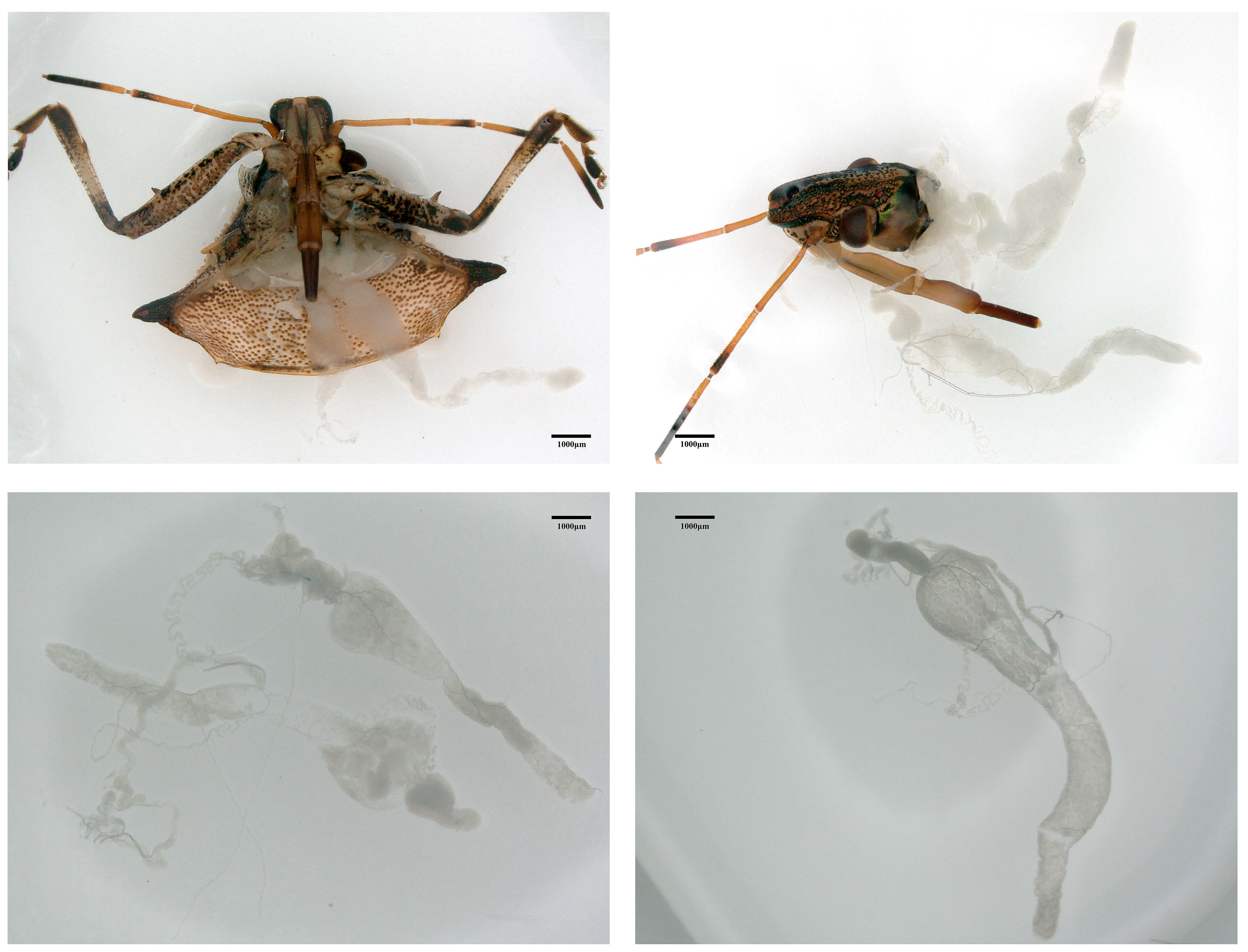
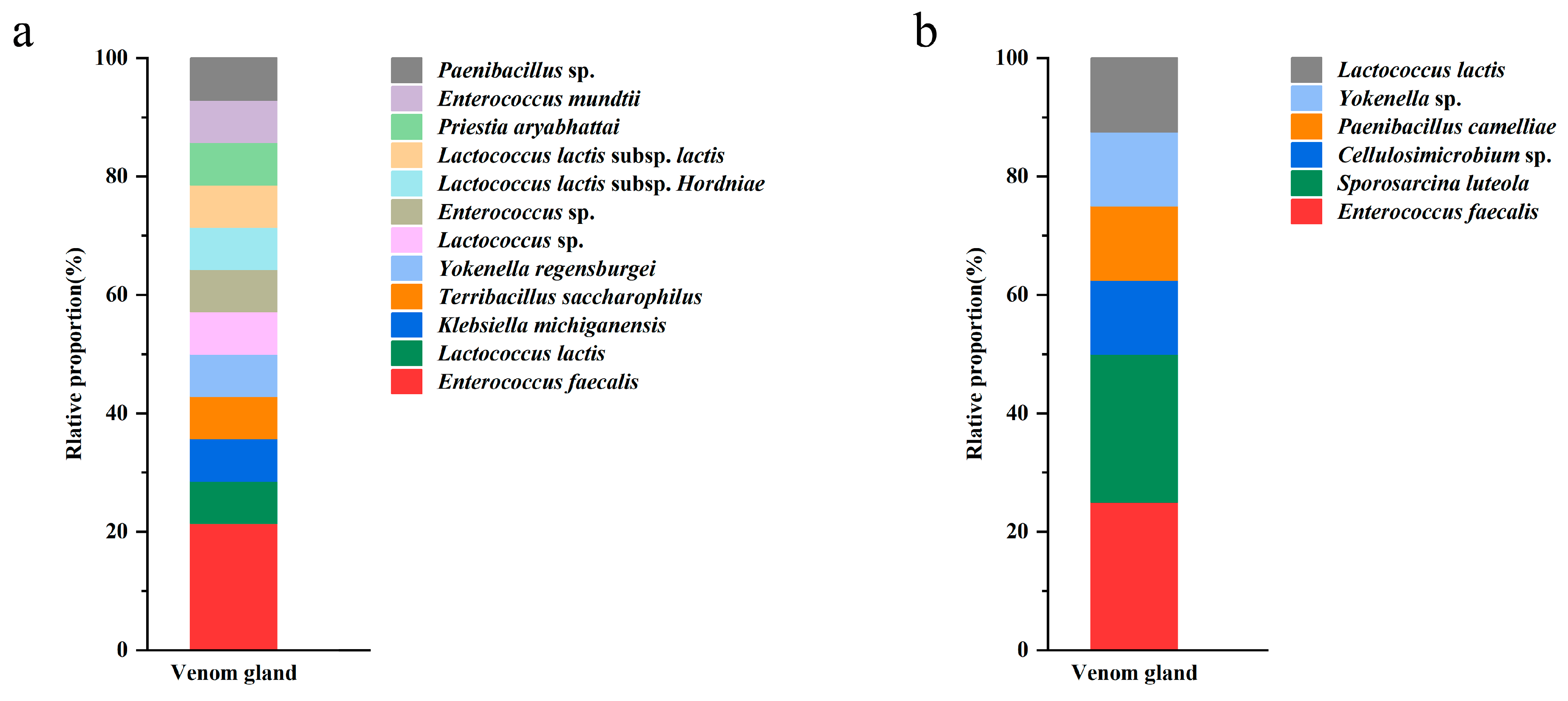
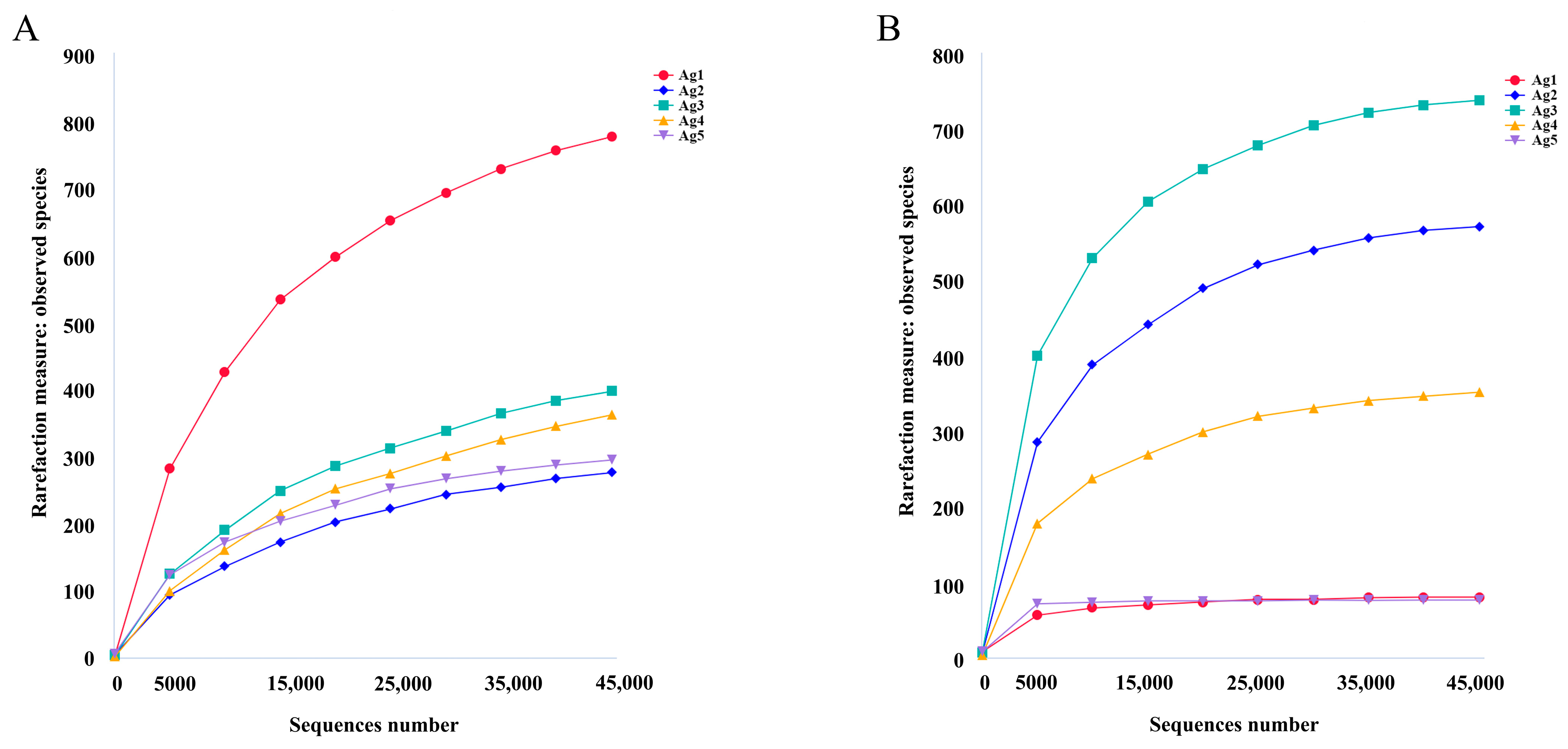


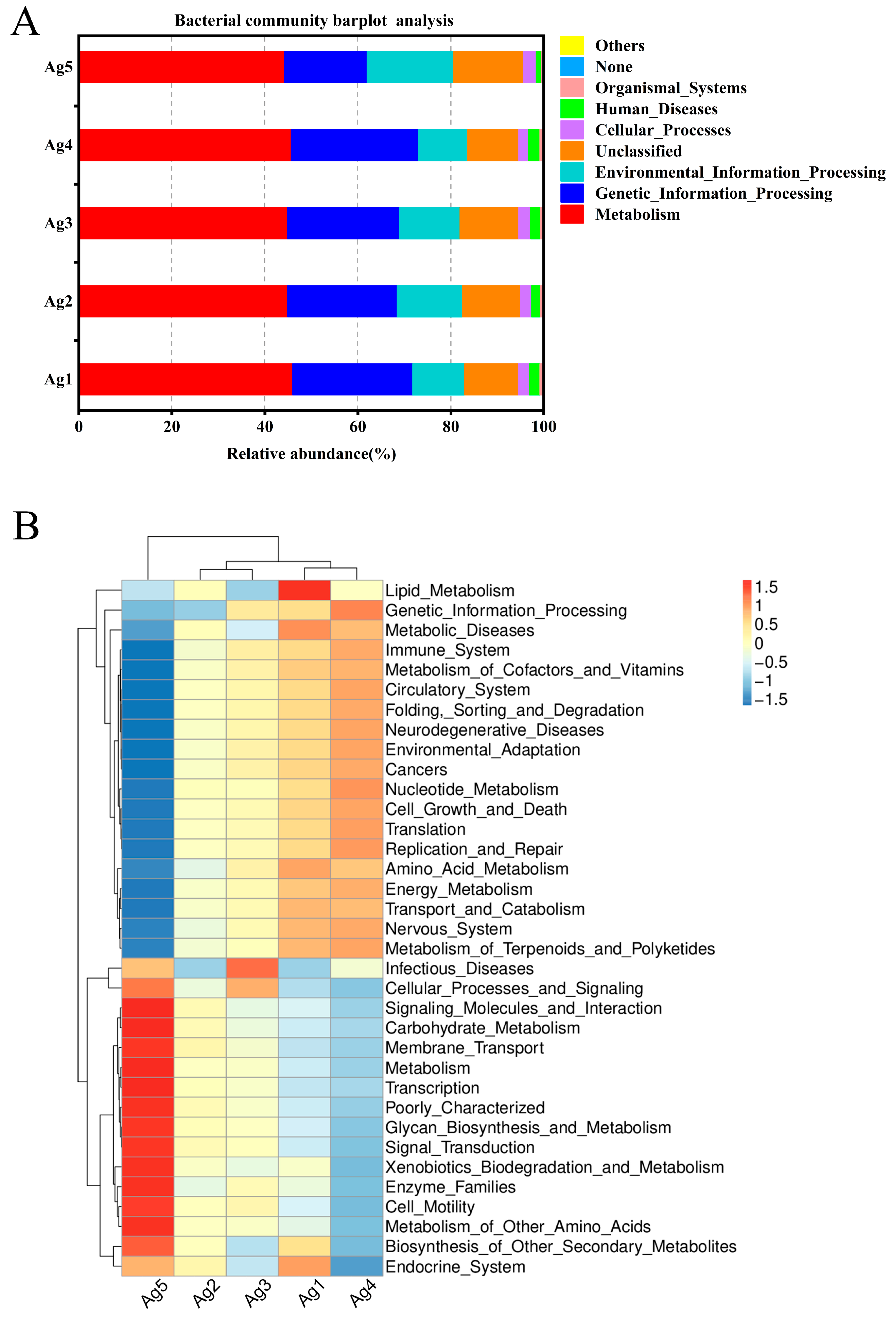
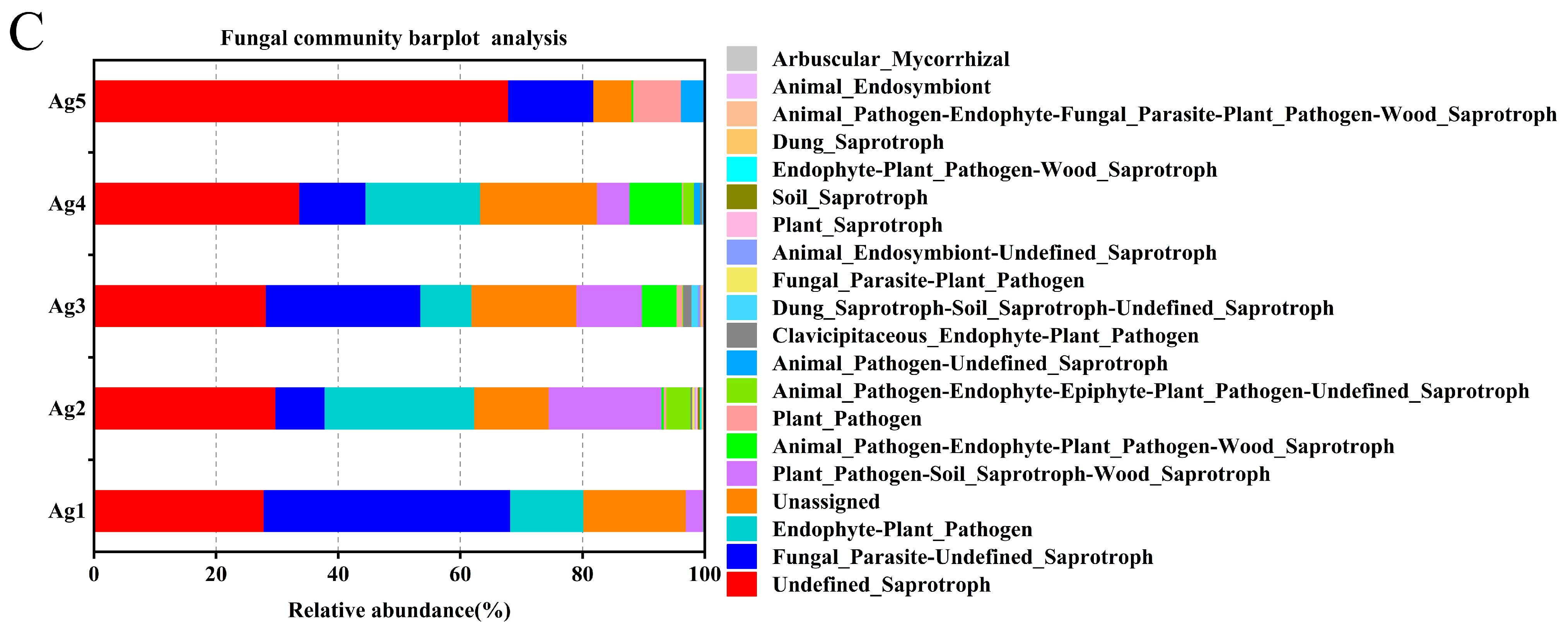

| Strain Designation | Closest NCBI Match | Accession Number | Similarity (%) |
|---|---|---|---|
| X1 | Klebsiella michiganensis | OR037498 | 99.67 |
| X2 | Terribacillus saccharophilus | OR037499 | 99.47 |
| X3 | Lactococcus lactis | OR037500 | 99.05 |
| X7 | Yokenella regensburgei | OR037501 | 99.25 |
| X8 | Lactococcus lactis subsp. lactis | OR037502 | 99.56 |
| X10 | Yokenella sp. | PP516327 | 97.52 |
| X11 | Enterococcus sp. | PP516328 | 96.53 |
| X12 | Enterococcus faecalis | PP5163299 | 98.45 |
| X13 | Lactococcus lactis subsp. hordniae | OR037503 | 99.67 |
| X15 | Lactococcus sp. | OR685638 | 99.47 |
| X18 | Priestia aryabhattai | OR037504 | 99.38 |
| X25 | Lactococcus lactis | OR685647 | 99.68 |
| X29 | Paenibacillus sp. | PP516330 | 97.63 |
| X30 | Enterococcus faecalis | PP516331 | 98.65 |
| X31 | Sporosarcina luteola | PP516332 | 98.60 |
| X32 | Sporosarcina luteola | PP516333 | 98.15 |
| X33 | Cellulosimicrobium sp. | PP516334 | 98.31 |
| X34 | Enterococcus faecalis | PP516335 | 98.86 |
| X36 | Paenibacillus camelliae | PP516336 | 99.78 |
| X37 | Enterococcus faecalis | PP516337 | 99.17 |
| X38 | Enterococcus faecalis | PP516338 | 98.69 |
| X39 | Enterococcus mundtii | PP516339 | 99.53 |
| Sample Groups | Diversity Indices b | |||||
|---|---|---|---|---|---|---|
| Observed Species a | Chao1 | Shannon | Simpson | Coverage | ||
| Bacteria | Ag1 | 775 | 847.25 | 1.67 | 0.27 | 0.996 |
| Ag2 | 275 | 301.81 | 2.52 | 0.71 | 0.998 | |
| Ag3 | 396 | 490.90 | 1.80 | 0.46 | 0.997 | |
| Ag4 | 361 | 478.47 | 0.68 | 0.11 | 0.997 | |
| Ag5 | 294 | 316.16 | 3.46 | 0.85 | 0.999 | |
| Average | 420.20 | 486.92 | 2.03 | 0.48 | 0.997 | |
| Fungi | Ag1 | 82 | 83.91 | 4.31 | 0.93 | 1.00 |
| Ag2 | 600 | 665.56 | 4.26 | 0.84 | 0.998 | |
| Ag3 | 794 | 857.52 | 4.89 | 0.86 | 0.998 | |
| Ag4 | 379 | 437.91 | 1.97 | 0.37 | 0.998 | |
| Ag5 | 76 | 76.00 | 4.35 | 0.90 | 1.00 | |
| Average | 386.20 | 424.18 | 3.96 | 0.78 | 0.999 | |
| Bacteria b | Fungi b | ||
|---|---|---|---|
| Class | Order | Class | Order |
| Alphaproteobacteria (61.5%) | Rickettsiales (60.9%) | Tremellomycetes (9.4%) | Tremellales (9.3%) |
| Bacilli (19.9%) | Lactobacillales (19.9%) | Sordariomycetes (6.5%) | Hypocreales (6.3%) |
| Gammaproteobacteria (16.6%) | Enterobacterales (15.6%) | Dothideomycetes (5.4%) | Capnodiales (3.2%) |
| Clostridia (0.4%) | Burkholderiales (0.4%) | Eurotiomycetes (2.8%) | Eurotiales (2.8%) |
| Bacteroidia (0.3%) | Lachnospirales (0.2%) | Agaricomycetes (1.7%) | Pleosporales (2.0%) |
| Actinobacteria (0.3%) | Bacteroidales (0.1%) | Saccharomycetes (1.2%) | Saccharomycetales (1.2%) |
| Acidobacteriae (0.2%) | Pseudomonadales (0.1%) | Mortierellomycetes (0.6%) | Mortierellales (0.6%) |
| Polyangia (0.1%) | Corynebacteriales (——) | Ustilaginomycetes (0.3%) | Ustilaginales (0.3%) |
| Thermoleophilia (0.1%) | Bifidobacteriales (——) | Malasseziomycetes (0.2%) | Malasseziales (0.2%) |
| Ktedonobacteria (——) a | Propionibacteriales (——) | Mucoromycetes (0.1%) | Corticiales (0.1%) |
| Carbon Source Type | Substrates | Metabolic Activity a,b,c |
|---|---|---|
| Carbohydrates | β-Methyl-D-Glucoside | +++ b |
| D-Xylose | ++ c | |
| α-Cyclodextrin | +++ | |
| Glycogen | +++ | |
| D-Cellobiose | +++ | |
| Glucose-1-phosphate | +++ | |
| α-D-Lactose | ++ | |
| Amino acids | L-Arginine | +++ |
| L-Asparagine | +++ | |
| L-Phenylalanine | +++ | |
| L-Serine | +++ | |
| L-Threonine | ++ | |
| Glycyl-L-glutamic acid | +++ | |
| Alcohols | I-Erythritol | +++ |
| D-Mannitol | ++ | |
| D, L-α-Glycerol | ++ | |
| Amines | N-Acetyl-D-glucosamine | +++ |
| Phenylethylamine | ++ | |
| Putrescine | +++ | |
| Acids | D-Glucosaminic acid | +++ |
| 2-Hydroxy benzoic acid | - a | |
| 4-Hydroxy benzoic acid | +++ | |
| γ-Hydroxybutyric acid | + | |
| D-Galacturonic acid | +++ | |
| Itaconic acid | - | |
| α-Ketobutyric acid | +++ | |
| D-Malic acid | +++ | |
| Esters | D-Galactonic acid lactone | +++ |
| Pyruvic acid methyl ester | +++ | |
| Tween 40 | +++ | |
| Tween 80 | +++ |
Disclaimer/Publisher’s Note: The statements, opinions and data contained in all publications are solely those of the individual author(s) and contributor(s) and not of MDPI and/or the editor(s). MDPI and/or the editor(s) disclaim responsibility for any injury to people or property resulting from any ideas, methods, instructions or products referred to in the content. |
© 2024 by the authors. Licensee MDPI, Basel, Switzerland. This article is an open access article distributed under the terms and conditions of the Creative Commons Attribution (CC BY) license (https://creativecommons.org/licenses/by/4.0/).
Share and Cite
Li, J.; Tian, X.; Hsiang, T.; Yang, Y.; Shi, C.; Wang, H.; Li, W. Microbial Community Structure and Metabolic Function in the Venom Glands of the Predatory Stink Bug, Picromerus lewisi (Hemiptera: Pentatomidae). Insects 2024, 15, 727. https://doi.org/10.3390/insects15090727
Li J, Tian X, Hsiang T, Yang Y, Shi C, Wang H, Li W. Microbial Community Structure and Metabolic Function in the Venom Glands of the Predatory Stink Bug, Picromerus lewisi (Hemiptera: Pentatomidae). Insects. 2024; 15(9):727. https://doi.org/10.3390/insects15090727
Chicago/Turabian StyleLi, Jinmeng, Xu Tian, Tom Hsiang, Yuting Yang, Caihua Shi, Hancheng Wang, and Wenhong Li. 2024. "Microbial Community Structure and Metabolic Function in the Venom Glands of the Predatory Stink Bug, Picromerus lewisi (Hemiptera: Pentatomidae)" Insects 15, no. 9: 727. https://doi.org/10.3390/insects15090727






